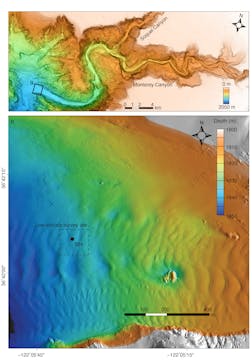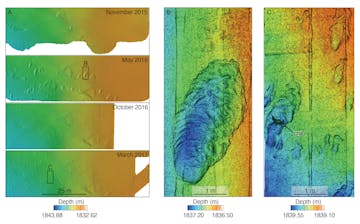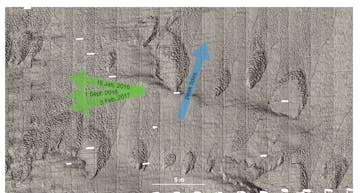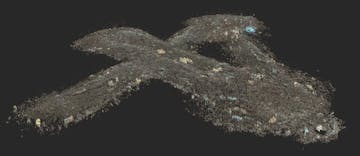“Thanks to MBARI’s engineering innovation, we now have the tools to map the deep seafloor in unprecedented detail, providing insight into the ecology and geology of this environment.”
—Principal Engineer Dave Caress

Monterey Canyon (A) is located just offshore of MBARI’s research facilities in Moss Landing, California. MBARI researchers conducted high-resolution, low-altitude surveys in a part of the canyon floor 50 kilometers (31 miles) from the canyon head (B) and deployed the Seafloor Instrument Node (SIN) to monitor environmental conditions, like currents, at the site to shed new light on processes that sculpt submarine canyons. Image: Monica Wolfson-Schwehr © 2023 MBARI

Four repeat surveys with MBARI’s LASS sensor suite between November 2015 and April 2017 provided an incredibly detailed view of changes to the floor of Monterey Canyon, including large migrating bedforms and smaller ripples and scours. The LASS combines various sensors, including sonar bathymetry (A) at a resolution of five centimeters (two inches) and lidar bathymetry (B and C) at a scale of one centimeter. Lidar data provide richer detail about the seafloor, revealing objects that are too small to be seen by sonar. Image: Monica Wolfson-Schwehr © 2023 MBARI

Lidar technology on MBARI’s LASS sensor suite uses pulses of lasers to record the bathymetry, or underwater topography, on the seafloor at centimeter-scale resolution. Surveys with the LASS suite at a scour field 1,840 meters (6,037 feet) deep on the floor of Monterey Canyon revealed how turbidity currents (green) and tides (blue) affected the structure of the seafloor. Image: Monica Wolfson-Schwehr © 2016 MBARI

Engineers from MBARI’s CoMPAS Lab are developing a Simultaneous Localization and Mapping (SLAM) framework using the LASS to generate three-dimensional maps of the seafloor in real time. Image: © 2023 MBARI



